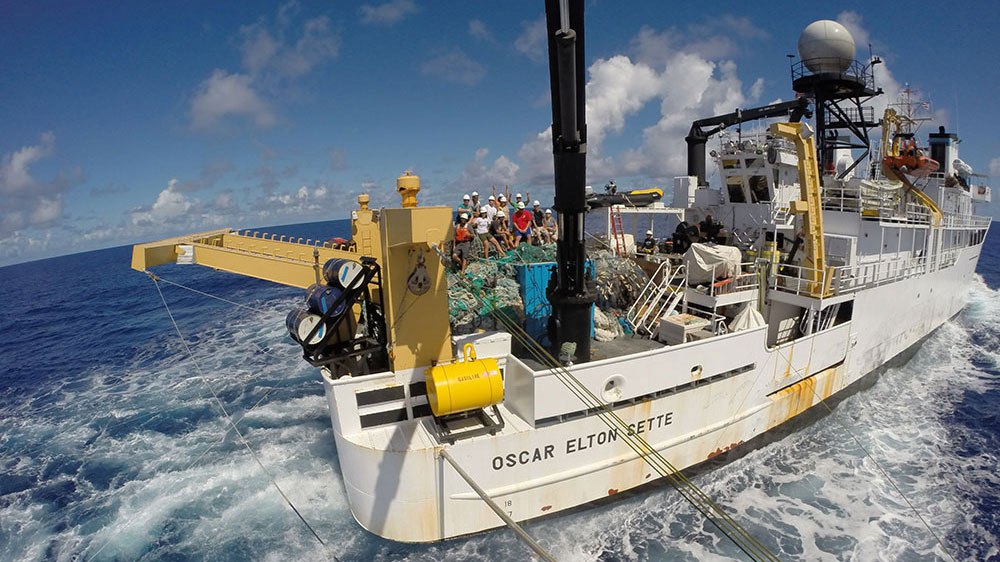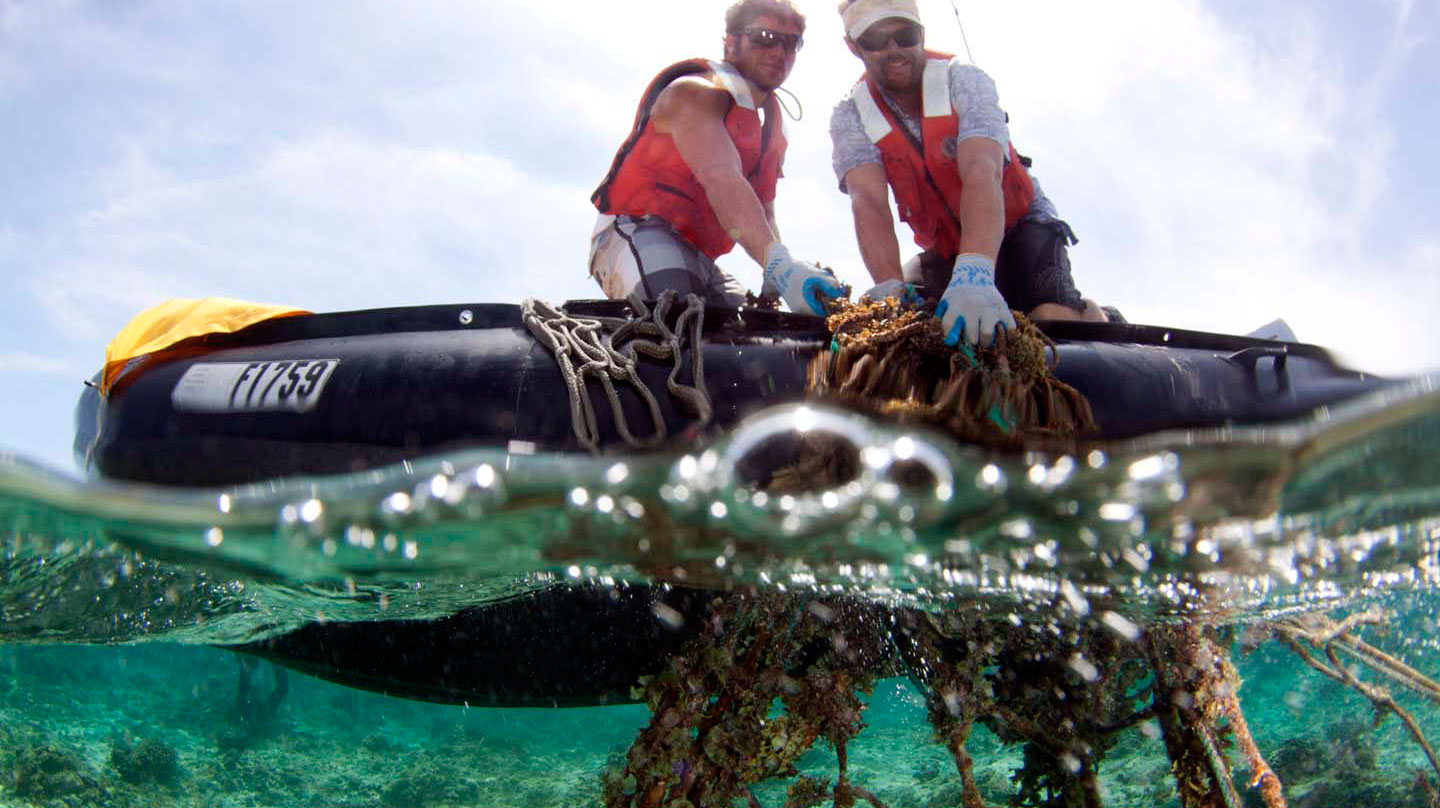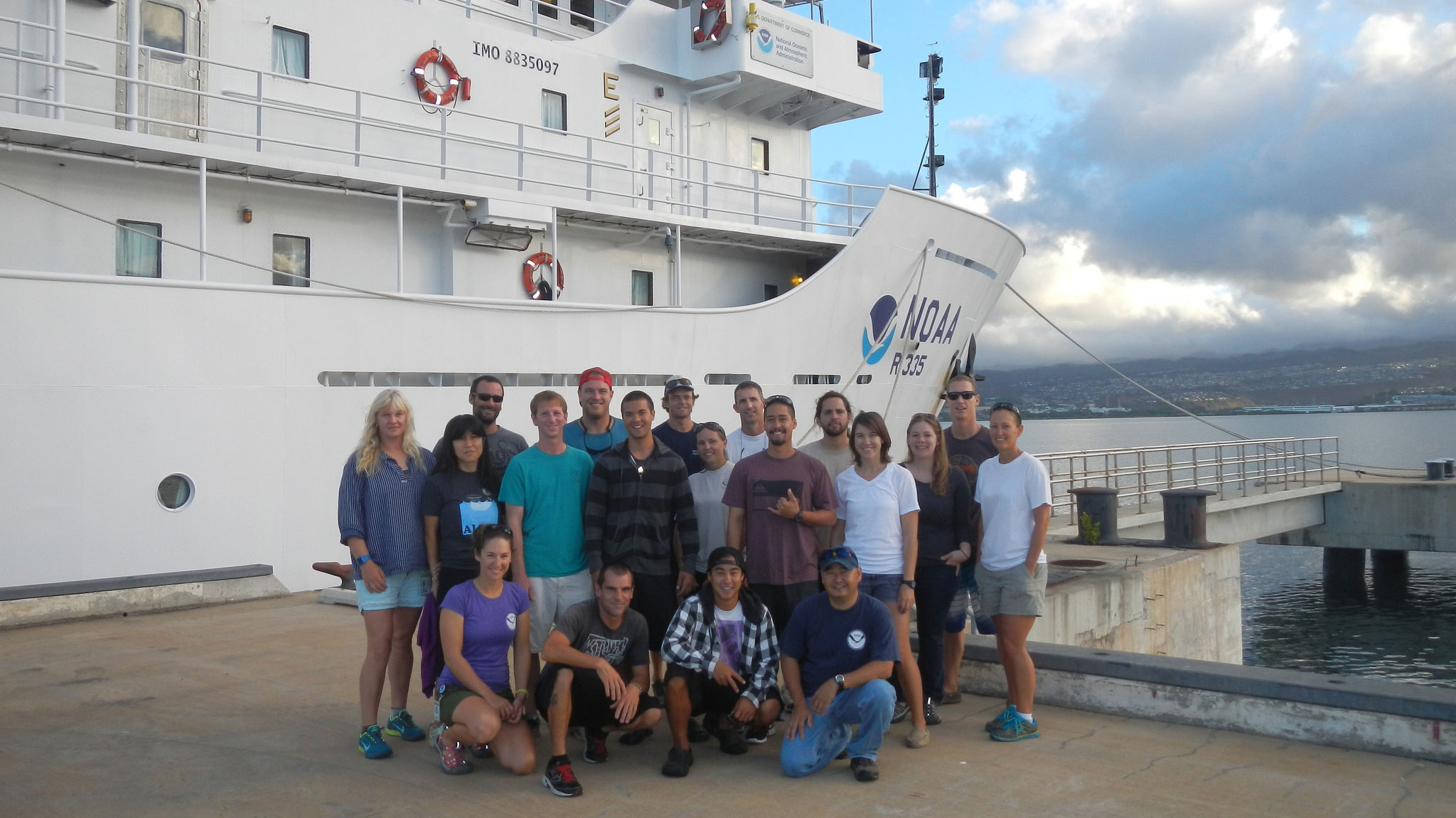NOAA removes 57 tons of marine debris from Northwestern Hawaiian Islands

NOAA Ship Oscar Elton Sette departing for marine debris survey and removal mission in Papahanaumokuakea Marine National Monument. Download ( Flickr)

A team of 17 NOAA divers helped remove 7,436 hard plastic fragments, 3,758 bottle caps, 1,469 plastic beverage bottles and 477 lighters and an 11 1/2 ton "super net." View/Download ( Flickr)

NOAA Ship Oscar Elton Sette departing for marine debris survey and removal mission in Papahanaumokuakea Marine National Monument. View/Download ( Flickr)
In this video, NOAA divers work on removing a massive underwater mass of abandoned fishing net. Download (right-click)
A team of 17 NOAA divers sailing aboard NOAA Ship Oscar Elton Sette has returned from a 33-day mission to remove marine debris from Papahānaumokuākea Marine National Monument in Hawaii, a World Heritage Site and one of the largest marine conservation areas in the world.
In total, they removed approximately 57 tons of derelict fishing nets and plastic litter from the monument’s tiny islands and atolls, sensitive coral reefs and shallow waters.
“The amount of marine debris we find in this remote, untouched place is shocking,” said Mark Manuel, operations manager for NOAA Fisheries Coral Reef Ecosystem Division and chief scientist for the mission. “Every day, we pulled up nets weighing hundreds of pounds from the corals. We filled the dumpster on the Sette to the top with nets, and then we filled the decks. There’s a point when you can handle no more, but there’s still a lot out there.”
At Pearl and Hermes Atoll, the divers encountered and rescued three sea turtles tangled in different nets. They also spent several days removing a 28-foot by 7-foot “super net” that extended 16 feet deep and weighed 11½ tons. The net, which had to be cut it into three pieces and towed separately back to the Sette, had destroyed coral in the atoll and posed a huge wildlife entanglement risk.
On the shorelines of Midway Atoll National Wildlife Refuge, also part of the monument, the team surveyed and removed nearly 6¼ tons of plastic trash, paying special attention to the bottle caps and cigarette lighters that are commonly eaten by birds. They removed and counted thousands of pieces of plastic, including 7,436 hard plastic fragments, 3,758 bottle caps, 1,469 plastic beverage bottles and 477 lighters.
The divers worked out of small boats launched from the Sette, systematically surveying coral reefs at Maro Reef, Pearl and Hermes Atoll and Midway Atoll by swimming and tow-boarding. They used maps marked with GIS locations that were based on 15 years of data on net accumulation hot spots and weather trends. Once the divers located a net--some of which were massive, tangled balls of several nets--they relied on their own physical strength and on ropes to remove it from the coral and into the boat.
NOAA has led this mission every year since 1996, removing a total of 904 tons of marine debris, including this year’s haul. The nets are an entanglement hazard for monk seals, turtles and seabirds that depend on the shallow coral reef ecosystem for survival. They also break and damage corals as they drift through the currents, snagging on anything in their path. Once they have settled, they can smother the corals and prevent growth.
“This mission is critical to keeping marine debris from building up in the monument,” said Kyle Koyanagi, Pacific Islands regional coordinator for NOAA’s Marine Debris Program. “Hopefully we can find ways to prevent nets from entering this special place, but until then, removing them is the only way to keep them from harming this fragile ecosystem.”
After the nets are unloaded from the Sette, they will become electricity as part of Hawaii’s Nets to Energy partnership with Covanta Energy and Schnitzer Steel. NOAA has sent the derelict nets from this mission to Nets to Energy since 2002, which has powered homes in Hawaii as a result.
The team alsorecovered two 30-foot boats at Pearl and Hermes Atoll, which are suspected to have come from Japan as a result of the 2011 tsunami. Two additional boats were also spotted but unable to be recovered. Following the mission, NOAA scientists will inspect the boats and work with the Japan consulate to determine their origin. Similar boats have turned up in Hawaii, the U.S. West Coast, and Canada over the past three years.
The Northwestern Hawaiian Islands, in addition to being an important cultural site for Native Hawaiians, give shelter to more than 7,000 marine species, including endangered Hawaiian monk seals, 14 million seabirds, rare and threatened land birds, and green sea turtles. They include 5,178 square miles of the healthiest and least disturbed coral reef habitat in U.S. waters.
They are also virtually pristine, except for an estimated 52 metric tons of derelict fishing gear that accumulates in the monument from sources around the Pacific Ocean every year. There is no estimate of how much plastic washes up on the islands, but they are heavily littered with buoys, bottles, toys, flip-flops, crates, and other trash, despite the islands being uninhabited.
Marine debris is a threat to our environment, navigation safety, the economy and human health. Huge amounts of consumer plastics, metals, rubber, paper, textiles, derelict fishing gear, vessels and other lost or discarded items enter the marine environment every day, making marine debris one of the most widespread, but preventable, problems facing the ocean and waterways. NOAA Fisheries, NOAA’s Ocean Service and NOAA’s Office of Marine and Aviation Operations, work together on this mission to protect the marine environment and keep our ocean resilient.
NOAA’s mission is to understand and predict changes in the Earth's environment, from the depths of the ocean to the surface of the sun, and to conserve and manage our coastal and marine resources. Join us on Twitter, Facebook, Instagram and our other social media channels.
Search Releases
Multimedia
More Information
NOS Media Contacts
- Dianna Parker (Email)
Phone:
240-687-8070 - Keeley Belva (Email)
Phone:
301-643-6463
